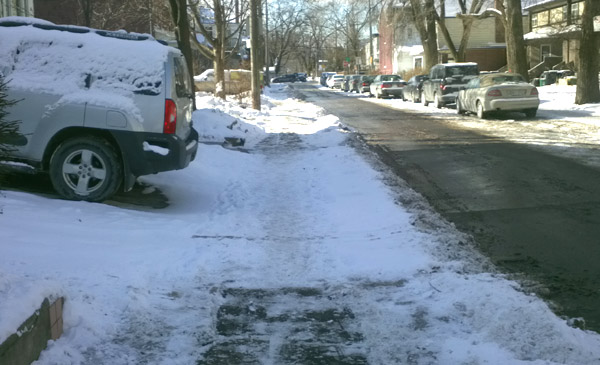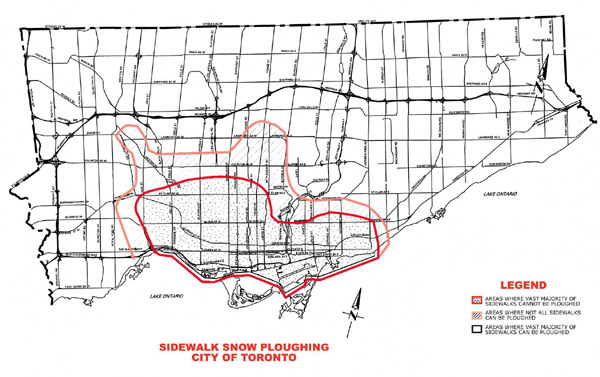In December, City Council agreed to a small but welcome improvement in the City’s snow clearing standards. Starting two winters from now (2015/16), the City will mechanically clear snow from sidewalks on main streets in the old city that have heavy pedestrian traffic (but only where their current sidewalk ploughs fit). The City has in fact been informally doing this ploughing in recent years when it can (after many complaints from the now-defunct Toronto Pedestrian Committee), but now it will be part of the City’s formal level of service requirements so they can’t just stop if staff decide it’s no longer convenient. It’s a useful step forward — it will be good for on-street retailers, and for the many downtown commuters who walk to work — and the City deserves credit for finally doing it.
One group it doesn’t really help much, however, is people with mobility difficulties and seniors who live in the old city. The reason? They are still going to have trouble getting to the now-clear main street sidewalks from their homes, because the City still won’t clear 1,100 km of residential sidewalks in a large swath of the old part of the city — the most densely populated part of Toronto. The City requires residents to clear their own sidewalks there. Most of them do — but it only takes one negligent homeowner to not do so for the sidewalk to become hazardous for a senior who fears a fall or someone who needs assistance moving, and potentially dangerous for anyone else too. Anyone who lives in the no-plough zone knows that, inevitably, there is someone on every block who is negligent, often an absentee landlord, and that means any snowfall or icy conditions makes pretty much every residential sidewalk in the old city dangerous for vulnerable people until the next melt.
The City does have a program to clear the sidewalk for seniors and people with disabilities who cannot do so themselves, but not only is this program implemented rather half-heartedly, it doesn’t help if someone else hasn’t cleared their sidewalk up the street.
The danger of slipping and falling for seniors is very significant. Not only might their balance be not as good as a younger person’s, putting them in greater danger of falling, but they are more likely to suffer a serious injury if they fall due to their weaker bones. A Danish study (PDF) found that, on a particularly icy day, there was a sharp increase in the number of pedestrians admitted to emergency. A disproportionate number of them were older people (especially women), who had suffered wrist and hip fractures.
The City claims that it can’t clear downtown residential sidewalks mechanically because they are too narrow, because there’s nowhere to put the snow on the side where cars are parked, and because they are worried about damaging fences, cars and other private property beside the sidewalks. It’s worth noting that it formerly used similar excuses for the main roads it has now promised to plough. In its report on winter maintenance (PDF) in December, the City rather ludicrously claimed that it would need 360 gangs of day labourers to clear old-city residential sidewalks manually, at a cost of $9,900,000 a year.
Other old cities with narrow sidewalks, however, such as Montreal and Ottawa, manage to find ways to clear their residential sidewalks mechanically. In a 2009 Toronto Star article on the issue, staff conceded that “that central sidewalks could be plowed if Toronto, like Montreal, spent “considerable resources” buying smaller tractors.”
It’s worth noting the current costs of not ploughing, as well. The City appears to spend $7-11 million dollars a year (PDF), possibly more some years, settling liability claims from slips and falls on ice and snow. It spends another half-million, the report says, on the seniors snow-clearing program. The report in fact notes that, if it wanted to cancel mechanical residential sidewalk clearing in the newer parts of the city where it currently exists, it would cost $4.5 million to extend the seniors sidewalk clearing program there — more than the current mechanical clearing costs (which also raises the question of whether the current central-city program is under-funded).
While it’s not clear where exactly those insurance claims were incurred, it’s worth pointing out that the total insurance payments often appear to be similar to the cost of even clearing old-city residential sidewalks by hand.
Added to the costs to the taxpayer, if not the city, is the price to the health care system of injuries caused by people slipping and falling. A study of slips and falls due to snow and ice in 2005/06 showed they resulted in 2,133 trips to the emergency room in Toronto. Of these, 222 people had to be hospitalized, 30% (68) of whom were over 65.
But more important than the costs is the simple accessibility issue. The Government of Ontario passed the Accessibility for Ontarians with Disabilities Act in 2005, which includes provisions for transportation and the design of public spaces. We are supposed to be moving towards a city and a province where everyone can expect a reasonable standard of accessibility from public services. We’ve put curb cuts on every sidewalk in the city; the TTC is building elevators in subway stations and only ordering new vehicles that are accessible. Yet these are irrelevant if seniors and people with disabilities can’t safely leave their house whenever it snows, and for days afterwards until that snow melts.
As the population ages, instituting effective residential sidewalk snow clearing in the old city would also be part of the necessary move towards “age-friendly cities“. Toronto recently unveiled a new “Seniors Strategy” — any such strategy must include making it safe for seniors to walk on the sidewalk after snowfalls.
The City’s attitude towards snow clearing on residential sidewalks in the old city is simply negligent. They are not cleared to a standard that is acceptable to make them functional. If the city absolutely cannot clear them mechanically, it would have to institute policies that made sure they really were cleared fully by residents: an expanded, comprehensive program to clear sidewalks for seniors and people with disabilities; some kind of youth employment program that people going on vacation, absentee landlords, and people with health issues could call on to pay to have their sidewalks cleared; active rather than passive enforcement by bylaw officers cruising streets and looking for uncleared sidewalk (it’s worth noting that Toronto has remarkably few bylaw enforcement officers — we should perhaps have more); and a thorough public education campaign to let people know about these measures.
In all likelihood, however, once all of these programs were in place and added to the budget, the City would discover that it could, in fact, afford to buy the necessary equipment and find ways to clear residential sidewalks in the old city mechanically.
In its December meeting, City Council directed staff to look more closely at sidewalks in wards that do not receive sidewalk ploughing, to see if any could be added. It also directed staff to look at all areas that aren’t being ploughed mechanically to “submit recommendations for sidewalk snow clearing using other means to ensure accessibility guidelines are maintained throughout the year.” Councillors have, rightly, created an opportunity to fix this long-standing problem. We need to see a comprehensive solution before next winter.







14 comments
Why go for the biggest snowplows, garbage trucks, fire trucks, etc. when smaller or narrower vehicles will do? We’ve seen European fire trucks that are narrower than North American trucks, and they handle emergencies just fine. Same with sidewalk plows. There is no need for wide plows when we only a path through the snow on the sidewalk.
During the weeks after the ice storm, many sidewalks in my area were seriously treacherous and I’m fully mobile. I noticed in my west end neighbourhood that it was the gentrified houses that had the worst sidewalk maintenance. There was one large corner lot, gorgeous home, that was surrounded on both sides with sheer ice. I can only guess that the inhabitants only walked as far as the car parked directly behind their home. The older Portuguese residents clear their sidewalks edge to edge right down to bare concrete. They should be applauded and I try to thank every person I see out shovelling. I know it was hard to get salt and the ice had to be physically chopped up, shovelling was useless but if people would just throw down sand or kitty litter it would help a lot.
Also, when you disconnect your downspout from the sewer, please do not direct the run off across the sidewalk.
http://www.youtube.com/watch?v=B6tpA4VNALI
How they roll in Montreal.
“…there is someone on every block who is negligent, often an absentee landlord…”
you forgot to add that tenants who rent an apartment in a house that has been split into three apartments automatically assume another tenant will clear the snow, or the landlord should be responsible, or the city should do it.
Couldn’t agree more. The City owns the sidewalk, its their responsibility to make sure its clean.
Since moving here from Montreal, I was at first shocked the city doesn’t clear the sidewalks. But then I also noticed that snow here typically melts after a few days. This winter’s different and navigating the sidewalks is a disaster.
I live in such a set up that @Hobbs describes, and yes, I don’t feel like I’m responsible to clear the City’s sidewalk. That’s one of the reasons people rent apartments, so that they don’t need to be responsible for maintenance.
The sidewalk no-plowing shows both Toronto’s cheapness and also its lack of respect for pedestrians.
Weird how car drivers get the streets plowed for them, but pedestrians don’t. Both are “taxpayers”. What’s up with this crappy customer service? A Maclean’s article on March 17th 2011 states “Winnipeg, for example, manages to keep its sidewalks free from snow and ice for $2 million a year, or less than $7 per household. Try finding a teenager willing to shovel your driveway just once for $7, let alone a whole season.” 7$ a year per household! Sign me up.
Liz – I think you must be in my neighbourhood, because I noticed the same thing. The only people I ever see out shovelling are the elderly Portuguese men. Funny, because I almost never see one of the many gym-bodied 30-40-somethings out shovelling.
I share a house that I rent and my landlord (who lives around the corner) insists we shovel. Upstairs in my house is a couple, one of whom is home at pretty much any time of day, neither of whom shovel. The yuppy artist family next door who shares our walkway also does not shovel. I sometimes work 12-16 hours a day and I’ll still shovel when I get home, even though the snow is pretty caked by the time I get to it. It’s a side street, but when I’m shovelling I count about a pedestrian a minute passing by, heading to the park or to stores nearby.
Seems like a crazy thing for the city NOT to plow.
Why go for the biggest snowplows, garbage trucks, fire trucks, etc. when smaller or narrower vehicles will do? Agreed
When one looks at the map it is largely the difference between older urban areas and more modern sprawling road rights-of-ways. As you mentioned there are numerous ways that snow can be cleared from sidewalks if the will was there.
My hope is that if the city purchased smaller equipment to clear urban sidewalks of snow or trucked it away, the city might eventually relax its codes for new suburban streets & development.
Unfortunately this change hasn’t yet affected the rules in Ottawa, where a common critique remains that new development is designed around the needs of snow removal & storage.
I have an honest question. Where are residents supposed to put the snow that they shovel off their own property? What about the snow they shovel off the sidewalks? I live on a side street with sidewalks and street parking and the snow always ends up on the street in a pile. This makes it near impossible for parallel parking in the winter time. What’s up with that?
Little Portugal: we could always adjust our allocation of space and take a bit away from the car to put some space between the sidewalks and the cars for snow and safety. Alas, the citizens of Toronto get outrageously upset whenever confronted with any change to transportation priorities, even when the change is better for everyone.
I think you’re seriously deluding yourself if you think that the city plowing the sidewalks will solve the problem. In Don Mills the sidewalks are plowed by the city, but that doesn’t necessarily make them usable. First, they only send out the plows after a certain amount of snow has fallen. Second, if there is only a bit of snow, they do not plow, they salt the sidewalks. Third, they don’t always plough to the bare concrete so there is either a skim of snow on the sidewalk or else, the snow melts and then freezers at night making the sidewalks very slippery. The above work okay for the mobile, but not so much for anyone using a walker and forget about a wheelchair. Just today, coming back from the store pulling a shopping buggy, I gave up on the sidewalk and switched to walking on the road. Mechanical plowing of sidewalks is not the panacea that people think it is.
The problem with mechanical snow clearing is that it doesn’t work. The plough tends to leave a centimetre or so of snow after it passes and then the wheels begin the process of packing down the snow and turning it to ice. We were better off when the individual homeowner/business used to clear the snow properly. Sidewalks covered in residual snow turned to ice are not acceptable to seniors. Sidewalks that are later heavily salted are no good to seniors or others with dogs. In the old days, sidewalks were cleared by the resident/business so that they were dry and safe within a day of any snowfall – and there was no need for salt.
Where are residents supposed to put the snow that they shovel off their own property?
Where to put snow requires common sense, putting the snow in places where it will least inconvenience people walking, biking, driving.
There is a law against shovelling snow onto a road, but unsurprisingly no corresponding law against shovelling snow onto a sidewalk. Otherwise city ploughs, which often clear road snow onto the adjoining sidewalk, would be the biggest offender.
As poor as city sidewalk clearing is, its better than leaving it up to the generosity of thousands of individuals, considering the lack of enforcement.
Strategy-wise, it might be best to first extend sidewalk clearing city-wide and then try to get the city to make it more of a priority.
Excellent article, but for one point. We need to stop characterizing homeowners who don’t shovel as negligent because that shifts the blame from the city to the homeowner. While I don’t doubt that there are many negligent homeowners, plenty of people who can’t access the city program have legitimate reasons for not shoveling. I normally try to shovel the sidewalk edge to edge but broke my leg a month ago (slipping on ice in the road, what’s this about suing the city?) so now I can’t. And then there are those time when delivery vehicles drive onto the sidewalk, pushing the snowbanks at the edge of the road over and flattening them so that they turn into solid blocks of ice that no amount of salt can break down. Safe and passable sidewalks will not happen until the city takes responsibility for it. Maybe the Ministry of Health can use their ER and fracture clinic savings to subsidize the snow removal costs. 🙂